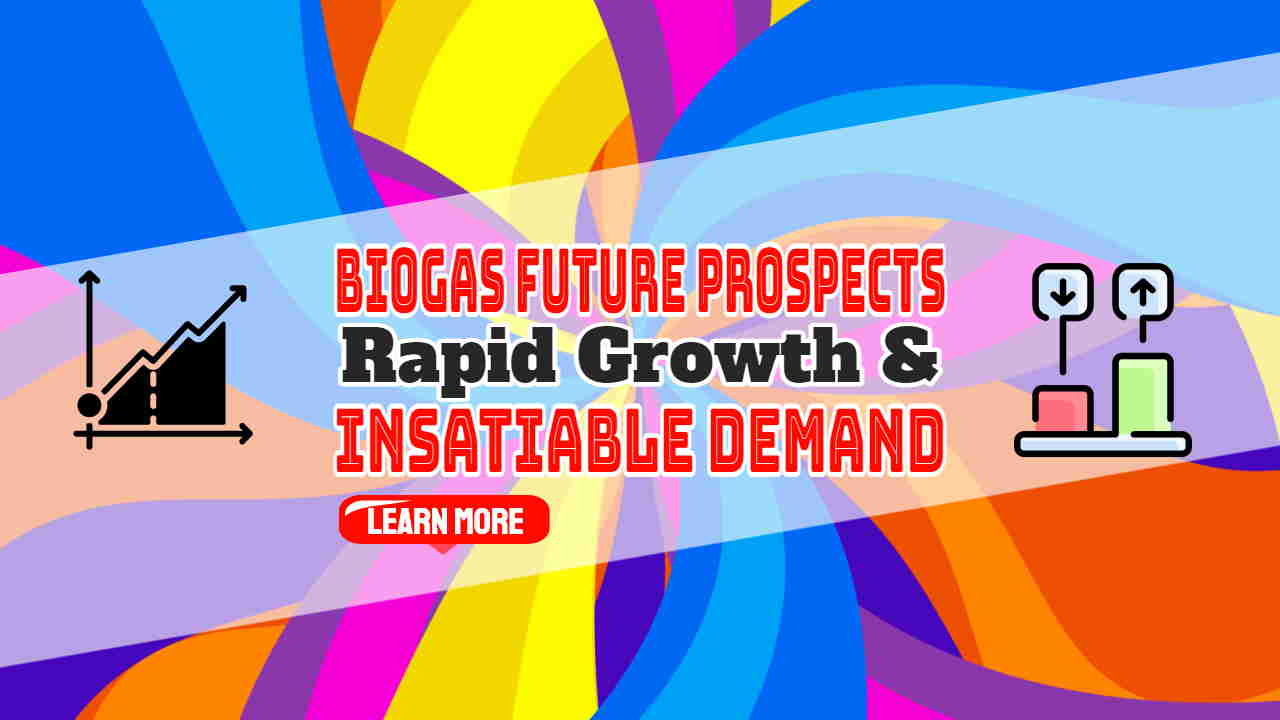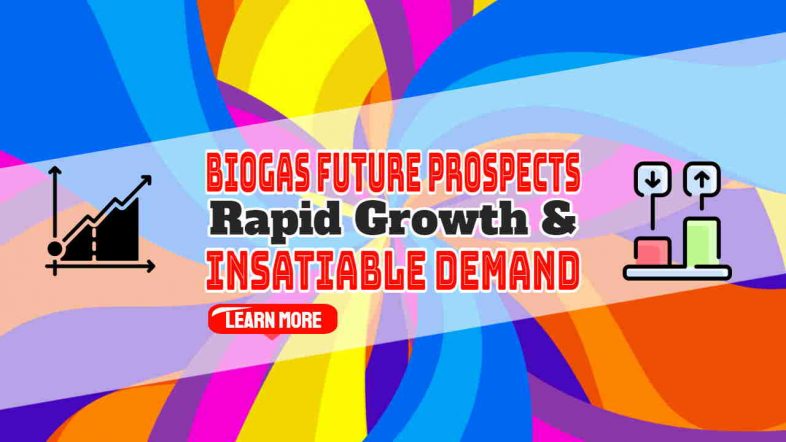Biogas' future prospects have never looked better. As they enter a period of rapid growth propelled by world events, there is an Insatiable demand for biogas. That is the “perfect storm” in prospect for anaerobic digestion technology because there is also an ever-increasing demand for reducing GHG emissions and RNG (biomethane) for transport use. So, biogas has never been more in demand.
Prospects Raised by a Combination of Global Events
Now that there are upgraded EU targets for the technology, it is clear that the industry will now grow rapidly, posing both challenges and opportunities.
Many countries have introduced significant positive legislative changes in relation to biogas production in recent years. But the energy crisis, which began in 2021, is now so pressing that it is forcing many governments to review and enhance the role of the biogas industry still further.
They are re-assessing and boosting their support schemes in the light of the following key developments:
- Non-renewable energy prices for oil and natural gas have at least doubled for many nations due to rising demand after the covid pandemic
- The Russian invasion of Ukraine in February 2022 increased natural gas prices due to nations moving away from Russian natural gas sources
- The increasing pressure to act on raising renewable energy output due to climate change imperatives.
The developments have drastically improved biogas plant profitability and reduced biogas plant investment risk. Through that will come the raised investment and increased biomethane production, which is vital in order to grow capacity and meet the booming market demand for renewable energy.
In the medium term, oil and gas prices will most likely fall back. However, the role of biogas in combating climate change will remain a major driver of future invested capital in the anaerobic digestion process.
Biogas Sector Growth Predictions
The global biogas market was expected to grow at an 8.9% compound annual growth rate (CAGR) from $58.90 billion in 2020 to $64.14 billion in 2021. Growth in 2022 will exceed this.
The increase is primarily due to companies resuming operations and adapting to the new normal while recovering from the COVID-19 impact. This is the welcome impact of the removal of restrictive measures such as social distancing, remote working, and the temporary closure of commercial operations. However, market forces and government support for the biogas industry will now accelerate further growth.
The biogas market is expected to reach $88.47 billion by 2025, growing at an 8.4%t CAGR.
Rising Importance of Biogas in National Energy Strategies
Biogas and biomethane are increasingly being recognised by EU institutions and Member States as important players in the future energy mix. The combined biogas and biomethane production in 2020 was 191 TWh, and this figure is expected to quadruple by 2030. Production could be more than fivefold by 2050, reaching over 1,000 TWh, with some estimates reaching 1,700 TWh.
The case for biogas and biomethane is at the crossroads of two critical modern-day challenges: dealing with the increasing amount of organic waste produced by modern societies and economies and reducing global greenhouse gas (GHG) emissions.
A Step Toward a Circular Economy
The conversion of organic waste into a renewable energy resource, biogas or biomethane, provides a window into a world where resources are continuously used and reused, and where rising demand for energy services can be met while also delivering broader environmental benefits.
The future of biogas and biomethane cannot be considered in isolation from the global energy system. Global energy has a wide range of possible futures, depending on the rate of technological innovation, the ambition of energy policies, market dynamics, societal trends, and a variety of other factors. This is based on an analysis which focuses on two scenarios from the IEA WEO: the Stated Policies Scenario (STEPS) and the Sustainable Development Scenario (SDS).
Biogas Upgrading Technology Advances
Modern developments in biogas upgrading techniques include hydrate separation, cryogenic separation, biological methods, membrane enrichment, in-situ upgrading, and multistage and high-pressured anaerobic digestion.

Future Biogas Development in the United States
Biogas is a methane and carbon dioxide mixture produced when organic material decomposes. Early research focused on feedstocks and developing guidelines for purifying biogas to pipeline quality.
SoCalGas is working to develop algae as an energy crop and is investigating the use of solar thermochemical processes to create renewable natural gas in the future.
In Escondido, California, they already have a full-scale commercial demonstration of biogas cleanup technology in operation at a wastewater treatment facility. Gas Grid companies across the nation are also involved in regulatory and policy initiatives to advance biogas.
The Future of Biogas Throughout Europe
The prospects for biogas in Europe are moving up a gear, with conservative estimates predicting a tenfold increase in output by 2030. Analysts say the industry will need to stay rooted in the local economy and be transparent about its environmental credentials if it wants to avoid a green backlash.
Biogas plants can be defined as a link between territory, agricultural production, and the agro-industrial system, helping to improve integration, sustainability, and land management. As a result, biogas is one of the energy sources that will play a far more active role in the coming years.
The European Biogas Association (EBA) is confident in renewable gas's future potential in Europe. The association, which was founded in February 2009, is dedicated to the deployment of sustainable biogas and biomethane production and use across the continent.
The EBA now has a well-established network of nearly 200 national organisations that cover the entire biogas and biomethane value chain in Europe and beyond.
Biogas Production Not Just for a Fuel but Heat As Well
Since the second half of the 2000s, the EU's energy and climate policies, as well as the implementation of various support schemes to encourage the use of renewable resources, have encouraged the development of biogas plants for the production of heat and methane. After a decade of steady growth, which has been largely resilient in the face of periods of political upheaval in various countries, it was estimated that there were 17,783 AD plants in operation in Europe at the end of 2017.
In 2017, which until now has been the best year for industry growth, the total installed electricity capacity of biogas plants in Europe (IEC) increased by 5%, reaching 10,532 MW, up from 8,355 MW installed and registered in 2014.
Biogas Output is Still Low in Proportion to Mainstream Energy Sources
Critics still say that biogas production is still so low in percentage terms as to be currently negligible. The entire European industry currently produces about 2 billion cubic metres (BCM) of biogas per year, which is a small fraction of total EU gas consumption, which is currently around 470 BCM per year.
“At the moment, it's nothing – it's peanuts,”
said Marc-Antoine Eyl-Mazzega, energy director at think tank the French Institute for International Relations (IFRI).
The majority of production is currently concentrated in Germany, which is home to approximately 9,500 biogas plants, accounting for more than half of the total number of installations in operation across the EU.
Bioenergy is defined as any energy derived from biomass, which includes recently living organisms and their metabolic byproducts. Biogas and biomethane production is categorised as bioenergy, and bioenergy will grow massively as a renewable energy source alongside others such as wind energy and solar.
Biogas Industry Thinks “Big” Will Come
However, the industry has lofty goals for the future, with France and Italy emerging as the new European leaders. According to a study commissioned by the industry consortium Gas for Climate, production in Europe could skyrocket to 98 billion cubic metres of biomethane by 2050, representing a 4,800% increase over current levels.
The biogas industry contributes to the goals of the energy transition by reducing greenhouse gas emissions and developing a circular economy through the recovery of digestates from agricultural methanization.
According to an ADEME-GRDF study, the growth of the biomethane industry as a natural gas substitute helps reduce greenhouse gas emissions by 188 grammes of CO2 equivalents for every kWh produced, injected, or consumed.
This equates to at least 750,000 tonnes of CO2 equivalents per year in France for a biomethane amount of 0.3 Mtoe (4 TWh) within this timeframe.
Biogas's Future in Asia
Co-benefits from biogas production can address a variety of sustainability priorities in developing economies, which are expected to account for three-quarters of global biogas production growth.
China, which already produces nearly a third of the global total, is attempting to increase rural biogas production in order to reduce air pollution caused by coal use while working to improve waste management practices, with plans to reach nearly 17 Mtoe (20bcm) by 2030. (from around 7Mtoe today).
India has offered financial assistance to local biogas cogeneration plants and has overseen the installation of over 5 million household biogas devices for clean cooking. Biogas prospects are boosted further by larger bioenergy targets in countries like Indonesia, Malaysia, and Thailand.
These countries will develop their biogas markets by utilising vast amounts of available residues generated by specific industry sectors, such as the palm oil industry.
Future Biogas – The Owner and Construction Contractor of AD Plants Grows Capacity
Future Biogas intends to build its own portfolio of 25 new biogas plants equipped with Carbon Capture and Storage (CCS) technology in order to supply green gas to the grid. It also plans to construct an additional 20 bolt-on CCS sites.
The CO2 will be delivered to the Northern Lights Project via a new port facility to be built in the™ Humber Estuary once it has been captured. Northern Lights™ is a joint venture formed by Equinor, Shell International, and Total Energies to transport and permanently store captured CO2 under the North Sea.
The company plans to sell the carbon offsets produced by permanent geological CO2 storage to corporate buyers looking to offset their emissions. It will also raise £35 million (€40.7 million), with AIM admission scheduled for July.
Future Biogas' plants have developed relationships with local farms from which it obtains crops such as maise, rye, and grass. The company's current crop supply is approximately 500,000 tonnes per year. Future also has long-term fixed-price agreements with farms, which help to decouple their income from commodity markets, giving them greater financial stability.
Future's network of farms will expand to support the planned expansion. Furthermore, they intend to retrofit existing and future plants with CCS technology, transforming us from a carbon-neutral company to one that actively reduces the amount of carbon in the atmosphere.
Conclusion
Biogas is a renewable green source of energy that is currently used in many developing countries as an alternative and renewable energy source for a variety of applications. The majority of countries are enacting legislation to regulate the biogas industry. Biogas is regarded as the renewable and sustainable energy of the future.
The demand for energy has risen steadily over the years, in lockstep with the global population growth. Fossil fuels are depleting, and the emissions from these fuels are wreaking havoc on the environment.
Global scientists have for 20 years or more been focusing on developing alternative energy production methods. Until now the anaerobic digestion and biogas industry has been steadily growing, but from now on expect to see a whole change of gear and very rapid expansion.
Back in July 2018 when we wrote the original article based on the views of ADBA, as archived below, we were also optimistic. As we now know, that assessment was correct. Read on to find out about more, still relevant, factors driving the biogas industry.
Biogas future prospects do look good for UK AD Plants! In the UK the future prospects for a thriving biogas industry, reducing UK carbon emissions are looking better than they have for many years.
That's our opinion, so we are delighted to be able to republish the latest Anaerobic Digestion and Bioresources Association (ADBA) Press Release below, which explains why they expect 50 or more new Anaerobic Digestion (AD) plants to be built, in the UK very soon.
ADBA Press Release on Biogas Future Prospects:
“Tide may be turning” for UK anaerobic digestion industry
Renewable technology has a “bright future” despite recent difficulties, says an industry body.
Global AD and biogas trade-show strikes positive note after tough years for UK industry
 The “tide may be turning” on future prospects for the UK anaerobic digestion (AD) industry, according to the head of the Anaerobic Digestion & Bioresources Association (ADBA).
The “tide may be turning” on future prospects for the UK anaerobic digestion (AD) industry, according to the head of the Anaerobic Digestion & Bioresources Association (ADBA).
ADBA Chief Executive Charlotte Morton said last week in her welcoming remarks at UK AD & World Biogas Expo 2018, the world’s largest international trade show dedicated solely to AD and biogas:
“The last few years have been very challenging for the UK AD industry. We’ve been operating in an environment of declining government support for renewable energy, with tariffs for renewable electricity and, until very recently, renewable heat steadily falling. There are, however, a number of reasons to believe that the tide may be turning and that AD in the UK has a bright future.”
“First, despite significant delays, changes to the Renewable Heat Incentive (RHI) have now finally come into effect, providing the kind of tariff rates for biomethane production that we were seeing five years ago as well as new tariff guarantees that lock in these rates over a set period. This is bringing £150-£300m of new investment to build a further 50+ biomethane plants. And whilst the current RHI scheme is due to close by 2021, the urgent need for more biomethane is resulting in calls from the Committee on Climate Change for the government to put in place a replacement before the end of this year.”
“There is also good news on the food waste side of the industry, with the European Union’s Circular Economy Package having come into force just last week. One of the key elements of the package is an obligation for EU Member States to bring in separate collections for biowaste by December 2023, and we fully expect the UK to adopt these targets in the Resources & Waste Strategy due out later this year.”
“Finally, there is considerable investment coming into the AD sector as part of an industry consolidation that involves refinancing and upgrading existing on-farm AD plants to improve their performance. This is expected to require £300m of opex across the industry per annum by 2020.”
And, on UK biogas' future prospects:
“So there’s a huge light at the end of the tunnel if we can just keep going through these tough times.”
AD and biogas technologies convert organic wastes and energy crops into renewable heat and power, clean transport fuel, and nutrient-rich biofertiliser, helping to reduce emissions whilst improving energy and food security and improving air quality.
While the UK AD industry already has sufficient capacity to power 1.2 million homes, the number of new AD plants being built has been falling in recent years, constraining the ability of the industry to help meet government decarbonisation goals across heat, and electricity, farming, waste, and transport. ADBA’s latest Market Report shows that AD in the UK is currently reducing emissions by 1% per year, but has the potential to reduce emissions by 5% if the industry reaches its full potential.
UK AD & World Biogas Expo 2018 was jointly organised by ADBA and the World Biogas Association (WBA) and brought together AD and biogas professionals from around the world to discuss the latest developments and innovations in the industry. Alongside an exhibition and full conference programme, highlights from the expo included a breakfast briefing for farmers on the opportunities for refinancing existing on-farm AD plants, a dedicated lunch and workshops for local authorities on introducing separate food waste collections, and a black-tie awards ceremony celebrating those making the greatest contribution to AD and biogas in the UK and around the world.
PRESS RELEASE ENDS
Anaerobic Digestion & Bioresources Association: www.adbioresources.org
More on Biogas Future Prospects
Prospects for a bright future for biogas and biomethane production to expand rapidly seem also to be echoed across the Atlantic, as evidenced by the following round-up of recent events:
Future Prospects for the Biogas and Biomethane Market by 2025
The researchers of this report show why sales of Biogas and Biomethane are projected to surge in the coming years. The study covers the trends that will strongly favour the industry during the forecast period, 2018 to 2025. Besides this, the study uncovers important facts associated with lucrative growth and opportunities that lie ahead for the Biogas and Biomethane industry. via Biogas and Biomethane Market Report
Biogas Future Prospects – New Report on US Biogas Market 2021
The study offers a comprehensive overview of the market scenario and involves market segments such as application/ type/ regions/ end-user (as applicable). Further, it examines extensive research on the market on the basis of current and historic sales, revenue, capacity, production status and market share for each manufacturer.
The future insights and prospects are then analyzed with the help of industry experts. via Report on US Biogas Market 2021
US: House subcommittee holds hearing on advanced biofuels, RFS
The House Committee on Energy and Commerce’s Subcommittee on Environment held a hearing on June 22 titled “Advanced Biofuels Under the Renewable Fuel Standard: Current Status and Future Prospects,” that included discussions of post-2022 RFS policy, the EPA’s misuse of RFS waivers, the potential for an octane fuel standard.
The event featured testimony from Brooke Coleman, executive director of the Advanced Biofuels Business Council, among others…
Coleman’s testimony focused primarily on how to generate growth in the advanced and cellulosic biofuels sectors, arguing that policy-makers should stay the course on the RFS. via advance bio fuels RFS
Your comments are welcome below on your opinion of biogas's future prospects.
[First published in July 2018. Updated July 2022.]








Fake news radar says -Biogas Future Prospects Look Good – Why ADBA Expects Many More UK AD Plants. Fake news warning. Beware speculative words used.